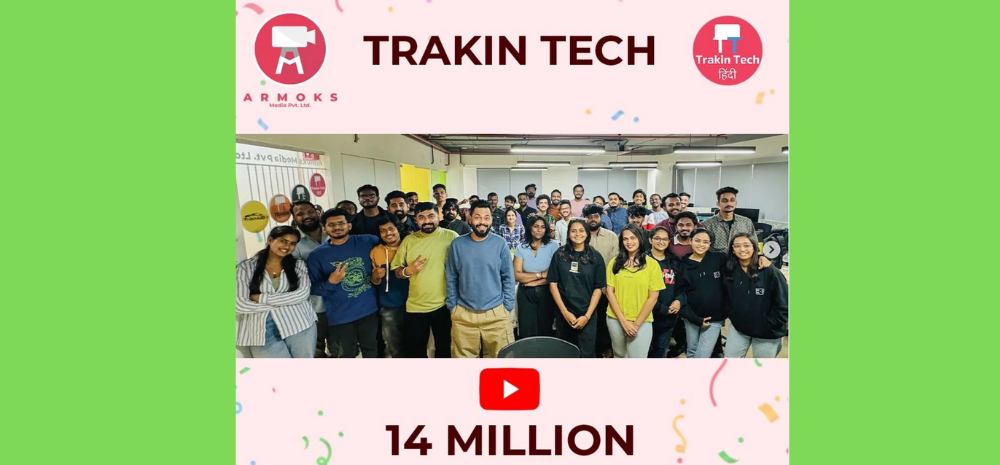Recently, we interacted with Mr. Sougandh K.M, Sales Development Manager, Universal Robots – an innovative robotics company of over 1,000 employees united behind a common vision – to create a world where people work with robots, not like robots.
![[Exclusive Interview] This 1000-Employee Robotics Company Is Unleashing An Automation Revolution With 50,000 Cobots](https://trak.in/stories/wp-content/uploads/2023/05/Untitled-design-18.png)
Here are the interview highlights:
- Please tell about Universal Robots
Universal Robots (UR) is a Denmark-based collaborative robots manufacturer that specializes to work alongside humans in various industries to increase productivity and safety. UR’s cobots have revolutionized the automation industry since their launch in 2008. UR has deployed over 50,000 cobots worldwide, making it one of the most successful cobot manufacturers in the world.
UR’s mission is to drive change in the way work is done, using their advanced robotics platform. Their product range includes cobots with various payloads and reaches, complemented by a broad range of end-effectors, software, accessories, and application kits in the UR+ ecosystem. The UR+ ecosystem allows customers to redeploy the same cobot across various industries and applications, making UR cobots one of the most versatile in the market.
UR cobots can perform a wide range of tasks, including material handling, picking, packaging, palletizing, component transfer, machine loading, assembling, welding, dispensing, and processing. UR’s technology is focused on enabling people and robots to work together to enhance efficiency.
The company’s vision is to create a world where people work with robots, not like robots. UR’s collaborative platform enables companies of all sizes to automate their production processes, regardless of their technical expertise and the size of the company. The company’s approach to automation ensures that any company, anywhere in the world, can automate its processes. With over 1,000 employees, UR is committed to revolutionizing the way work is done by driving innovation and making cobots accessible to all.
- What is a cobot and how does it differ from a traditional industrial robot?
Traditional industrial robots are programmed to work in a specific location and typically carry out repetitive tasks with high precision. They are often large and heavy and require extensive safety fencing. Safety protocols must be in place to protect workers from the potential risks of injury from these robots, which can move quickly and with significant force.
On the other hand, cobots are designed to work alongside humans, with built-in safety features such as force control and sensors. These features allow cobots to automatically slow or stop their actions when a human approaches, making them safer to work with. Cobots are typically smaller and lighter than traditional industrial robots, and they are versatile and can be moved between different tasks and locations. This makes them more flexible and adaptable than traditional robots, as they can be quickly reprogrammed to perform new tasks, reducing the need for dedicated production lines.
They are highly flexible and can carry out a range of tasks such as packing, palletizing, weightlifting, and machine tending. Cobots can take over tasks that are risky, dull, or repetitive, leaving the human workforce to focus on more complex and value-adding tasks.
Cobots and traditional industrial robots have some similarities in the range of activities they perform, but the key difference between them is their design and safety features and cobots are way cheaper than the industrial robots. They are more flexible and versatile, enabling them to be reprogrammed quickly to perform new tasks, reducing the need for dedicated production lines. As technology continues to evolve, cobots are becoming more prevalent in various industries, and they are expected to play an increasingly significant role in the future of industrial automation.
- What are the advantages of using cobots in manufacturing processes?
Cobots play a vital role in manufacturing processes, especially in increasing the efficiency and output of the production unit. Here are some advantages of using cobots:
- Increased productivity: Cobots can work alongside human workers, assisting them in performing tasks, which leads to increased productivity. By automating repetitive and mundane tasks, cobots allow human workers to focus on more complex and value-adding activities.
- Improved efficiency: Cobots can operate round the clock without the need for breaks or rest, ensuring consistent and reliable performance. They can also work at a faster pace and with high precision, leading to improved efficiency in manufacturing processes.
- Enhanced safety: Cobots are designed with built-in safety features, such as force control and sensors, that allow them to work safely in close proximity to humans. This reduces the risk of accidents and injuries in the workplace. Unlike traditional robots, cobots can automatically slow down or stop their actions when a human enters their workspace, minimizing the chances of collisions or harm.
- Flexibility and adaptability: Cobots are highly flexible and can be easily programmed and reprogrammed to perform different tasks. They can be quickly integrated into existing production lines and adapted to new processes, allowing manufacturers to respond swiftly to changing demands or product variations.
- Cost-effectiveness: Compared to traditional industrial robots, cobots are often more cost-effective. They have a lower upfront cost, require less infrastructure (such as safety fencing), and are easy to set up. Additionally, cobots can be easily redeployed to different tasks or locations, maximizing their utilization and providing a higher return on investment.
These advantages make cobots a valuable tool for manufacturers seeking to optimize their operations and stay competitive in a rapidly evolving industry
- What factors should be considered when choosing a cobot for a specific application?
When choosing a cobot for a specific application, several factors should be carefully considered. These include:
- Task requirements: Evaluate the specific tasks that the cobot needs to perform in the application. Consider factors such as the payload capacity, reach, and precision required for the tasks. Ensure that the cobots capabilities align with the application’s needs.
- Safety considerations: Assess the safety requirements of the application. Consider whether the cobot needs to work near humans and whether it requires specific safety features such as force control, collision detection, or speed reduction when humans approach. Ensure that the cobots safety features meet the necessary standards and regulations.
- Ease of programming and integration: Consider the ease of programming a cobot for the desired tasks. Look for user-friendly programming interfaces or intuitive software that simplifies the setup and configuration process. Additionally, assess the cobots compatibility with existing equipment and systems in the application to ensure smooth integration.
- Flexibility and adaptability: Evaluate the cobots flexibility to perform various tasks and its ability to be redeployed for different applications. Look for a cobot that can be easily programmed and reprogrammed, allowing for quick adaptation to changing production needs or new tasks.
- Cost-effectiveness: Assess the overall cost of the cobot, including upfront costs, maintenance expenses, and potential return on investment. Consider the cobots productivity gains, reduced labour costs, and potential for increased efficiency. Balance the cost with the expected benefits to determine the long-term cost-effectiveness.
- Support and service: Consider the availability and quality of technical support, training, and after-sales service provided by the cobot manufacturer. Ensure that the manufacturer offers timely assistance and has a reliable service network to address any issues or maintenance needs that may arise.
By carefully considering these factors, businesses can choose the most suitable cobot for their specific application, ensuring optimal performance, safety, and cost-effectiveness.
- How do cobots interact with human workers, and what measures can be taken to ensure their safety?
Cobots are designed to work in a collaborative manner. They are equipped with advanced safety features, such as ISO/TS 15066 safety guidelines which include saety rated monitored stop, hand guiding, speed and separation and power and force limiting, to ensure safe collaboration with humans. Here are some ways in which cobots interact with human workers and measures that can be taken to ensure their safety:
- Collaborative operation: Cobots are designed to work collaboratively with human workers. UR’s cobots are AI-powered cobots which are specifically programmed to detect the presence of humans and adjust their actions accordingly. For example, the hand guiding operation, the human operator uses a hand-operated device and the robot system moves based on motion commands of the operator
- Safety-rated stop: Cobots are equipped with sensors that enable them to detect when they come into contact with an object or a person. If a collision is detected, the cobot will immediately stop its movement to prevent injury. For example UR’s safety-rated monitored stop, the robot system stops before the human operator can access or be exposed to any hazard in the collaborative workspace
- Risk assessment: It is important to conduct a thorough risk assessment before deploying a cobot in a workspace. This will identify any potential hazards and help to establish appropriate safety measures.
- Proper training: Human workers should be trained in the safe operation of cobots. They should understand how to work collaboratively with cobots and how to respond in case of an emergency.
- Regular maintenance: Regular maintenance of cobots is of paramount importance to ensure that they are operating at peak efficiency. This includes regular inspections and maintenance of safety features such as sensors and emergency stop buttons.
- What are some examples of successful implementations of cobots in industrial settings?
Cobots are easy to deploy, requiring minimal training and infrastructural changes at low-cost. There have been numerous successful implementations of cobots in various industrial settings. Here are a few notable examples:
- Automotive Industry: Cobots have found extensive use in the automotive industry. For instance, Nissan Motor Company implemented cobots for tasks such as assembling small parts, applying adhesives, and performing inspections. Cobots work collaboratively with human workers, enhancing productivity and precision while ensuring worker safety.
- Electronics Industry: Cobots have been successfully implemented in the electronics industry for tasks like circuit board assembly, soldering, and quality control. Companies like Schneider Electric have integrated cobots into their production lines to improve efficiency, quality inspection, material handling and material removal processes.
- Food and Beverage Industry: Cobots have made significant inroads in the food and beverage industry. They assist in tasks such as packaging, palletizing, and food handling. For example, Unilever, a leading FMCG company deployed cobots to speed up their palletizing process and, reducing the physical strain on workers.
- Healthcare Industry: Cobots have found applications in the healthcare industry as well. They assist in tasks such as patient handling, medication management, and laboratory automation. For instance, Universal Robots collaborated with a hospital in Denmark to develop a cobot that can disinfect hospital rooms, minimizing the risk of infections.
These are just a few examples of successful cobot implementations in industrial settings. Cobots continue to find applications in a wide range of industries, driving increased efficiency, productivity, and safety. As technology advances and cobots become more accessible, their potential for successful implementation in industrial settings is expected to expand even further.
- What are some of the latest developments in cobot technology, and how might they impact the future of manufacturing and other industries?
Cobot technology has been advancing rapidly in recent years, and there are several exciting developments that could have a significant impact on the future of manufacturing and other industries. Here are a few examples:
- Advanced Sensing and Perception: Cobot manufacturers are increasingly integrating advanced sensors and perception capabilities into their products, allowing cobots to better detect and adapt to their environment. This could enable cobots to work more collaboratively and safely with humans, as well as increase their ability to perform complex tasks with greater precision and efficiency.
- Artificial Intelligence and Machine Learning: As cobots become more advanced, they are also incorporating AI and machine learning capabilities. This allows them to learn from their experiences and adapt to new situations, making them more versatile and flexible in their applications. AI-powered cobots can also be programmed to detect and correct errors in real time, improving efficiency and reducing the need for human intervention.
- Cloud Connectivity and Data Sharing: With the increase in cloud-based technologies, cobots can now be connected to cloud platforms to share data and enable remote monitoring and control. This could make it easier for manufacturers to manage and optimize their production processes, as well as enable greater collaboration between different stakeholders.
Overall, these advancements in cobot technology are expected to drive increased efficiency, productivity, and safety in manufacturing and other industries. With cobots becoming more sophisticated and versatile, they could also enable new applications and use cases, leading to further innovation and growth in the field.










